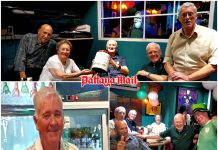If you suffer a ruptured abdominal aortic aneurysm (AAA), you could die if you don’t get to the hospital within ten minutes. That’s how long it would take you to lose all the blood in your body. This dire warning was how Dr. Sujit Banyatpiyaphod, MD, Medical Director of the Heart Center at Bangkok Hospital Pattaya (BHP), started his talk as guest speaker at the February 21 meeting of the Pattaya City Expats Club. He definitely got the crowd’s attention.
Dr. Sujit defined an aneurysm as a full-thickness dilation of a segment of a blood vessel 50 percent greater than its normal diameter. Although an aneurysm can occur in other blood vessels, it is most dangerous when it occurs in the aorta, the major blood vessel that runs from your heart through the center of your chest and abdomen and supplies blood to the body. Dr. Sujit said the aorta is a long organ, so an aneurysm could happen in many places; but about 90 percent of them are abdominal.
 Dr. Sujit shows a diagram of an abdominal aortic aneurysm (AAA). He explained that if diagnosed with AAA, surgical intervention may not be required unless it continues to grow to a size where it becomes a high risk for rupturing.
Dr. Sujit shows a diagram of an abdominal aortic aneurysm (AAA). He explained that if diagnosed with AAA, surgical intervention may not be required unless it continues to grow to a size where it becomes a high risk for rupturing.
According to Dr. Sujit, smoking is a major risk factor for aneurysm formation and is one of the strongest independent risk factors for AAA. Caucasian men of advancing age are most susceptible. Other risk factors include atherosclerosis, a family history of AAA, other peripheral artery aneurysm (iliac, femoral, popliteal), connective tissue disorder (e.g., Marfan, Ehlers-Danlos, Loeys Dietz syndromes), prior history of aortic dissection, and prior history of aortic surgery or instrumentation.
During AAA formation, thrombus builds up gradually along the wall as the aorta expands over time. According to Dr. Sujit, most patients with AAA have no symptoms. When symptoms do occur, pain located in the abdomen, back, or flank is the most common complaint. Because the blood flow to your legs might be restricted, you might also feel numbness, tingling, or burning in your legs, or you might experience claudication, which is discomfort or pain in your legs that happens when you walk and goes away when you rest. You may not always feel pain; instead you may feel a tightness, heaviness, cramping, or weakness in one or both of your legs. However, he cautioned that such pain may or may not be associated with AAA.
If you suspect you might have an aneurysm, don’t touch it – and definitely don’t have a massage – because pressure could cause it to rupture. If that happens, you will have a sharp pain like someone stabbed you with a knife, followed by profuse sweating, followed by shock or hypotension. That’s when you could have 10 minutes to get in the operating room. Once an aneurysm ruptures, 50% of patients die before they reach the hospital. The good news is that at Bangkok Hospital Pattaya, Dr. Sujit only sees a ruptured AAA four or five times a year.
So since AAA is usually asymptomatic and could kill you within ten minutes, how can you prevent it, and how can it be diagnosed? First, stop smoking. Second, have an annual checkup. An abdominal ultrasound is a noninvasive, inexpensive way to diagnose and monitor the size of an AAA. If you show symptoms of an AAA, a CT scan can provide additional details.
Dr. Sujit said there are two approaches for repairing abdominal aortic aneurysms. Each patient is different and the decision to repair an AAA depends upon the size and location of the aneurysm, the age of the patient, underlying medical conditions, and life expectancy.
 MC Richard Silverberg presents Dr. Sujit with the PCEC’s Certificate of Appreciation for his interesting and informative talk about abdominal aortic aneurysms, which no doubt will result in his older listeners adding ultrasound of the abdomen to their annual physical examinations.
MC Richard Silverberg presents Dr. Sujit with the PCEC’s Certificate of Appreciation for his interesting and informative talk about abdominal aortic aneurysms, which no doubt will result in his older listeners adding ultrasound of the abdomen to their annual physical examinations.
The first is the traditional surgical approach. A large incision is made in the abdomen, and the aortic aneurysm is identified and cut out or resected. The missing piece of aorta is replaced with a synthetic graft. The surgery usually lasts several hours, and may require 10 days of recuperation in the hospital.
The second approach is Endovascular Aortic Repair (EVAR). This involves placing an endovascular graft, or stent. A catheter or tube is threaded into the femoral artery in the groin and the graft is positioned so that it spans and sits inside the aneurysm and protects it from expanding. EVAR doesn’t require surgically opening the chest or abdomen. It reduces recovery time to a few days and greatly reduces time in the hospital. Not all AAA can be repaired with this procedure, and it can’t be used if the AAA has ruptured. But the main drawback is the cost: according to Dr. Sujit, it could cost as much as one million baht.
After Dr. Sujit answered several questions from the audience, MC Richard Silverberg brought everyone up to date on Club and other events and called on Ira Wettenstein to conduct the Open Forum, where questions are asked and answered about Expat living in Thailand, especially Pattaya.
For more information on the PCEC’s many activities, visit their website at www.pcecclub.org.




